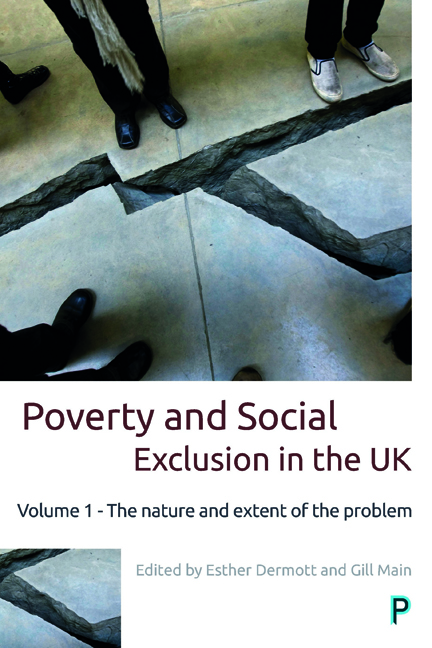Book contents
- Frontmatter
- Dedication
- Contents
- List of tables and figures
- Notes on contributors
- Acknowledgements
- Introduction: poverty and social exclusion in the UK
- One Measuring poverty in the UK
- Two The impoverishment of youth: poverty, deprivation and social exclusion among young adults in the Uk
- Three Improvement for some: poverty and social exclusion among older people and pensioners
- Four Which men and women are poor? Gender, poverty and social exclusion
- Five Better understandings of ethnic variations: ethnicity, poverty and social exclusion
- Six Improving lives? Child poverty and social exclusion
- Seven The cost of children: parents, poverty, and social support
- Eight A worsening picture: poverty and social exclusion and disabled people
- Nine Devolution and North/South division: poverty and social exclusion in the countries and regions of the UK
- Ten More similarities than differences: poverty and social exclusion in rural and urban locations
- Conclusion: innovating methods, informing policy and challenging stigma
- Technical appendix
- Index
Six - Improving lives? Child poverty and social exclusion
Published online by Cambridge University Press: 08 April 2022
- Frontmatter
- Dedication
- Contents
- List of tables and figures
- Notes on contributors
- Acknowledgements
- Introduction: poverty and social exclusion in the UK
- One Measuring poverty in the UK
- Two The impoverishment of youth: poverty, deprivation and social exclusion among young adults in the Uk
- Three Improvement for some: poverty and social exclusion among older people and pensioners
- Four Which men and women are poor? Gender, poverty and social exclusion
- Five Better understandings of ethnic variations: ethnicity, poverty and social exclusion
- Six Improving lives? Child poverty and social exclusion
- Seven The cost of children: parents, poverty, and social support
- Eight A worsening picture: poverty and social exclusion and disabled people
- Nine Devolution and North/South division: poverty and social exclusion in the countries and regions of the UK
- Ten More similarities than differences: poverty and social exclusion in rural and urban locations
- Conclusion: innovating methods, informing policy and challenging stigma
- Technical appendix
- Index
Summary
Introduction
This chapter details findings on child poverty and social exclusion from the 2012 UK Poverty and Social Exclusion Survey (PSE-UK 2012). The 1999 Poverty and Social Exclusion Study of Great Britain (PSE-GB 1999), which at the time offered the most comprehensive data on child poverty and social exclusion gathered in Britain, was completed amidst an atmosphere of hope in relation to the outlook for poor children and families. New Labour’s landslide victory in the 1997 general election was followed by then Prime Minister Tony Blair’s commitment in 1999 to end child poverty within a generation. This commitment was made in the aftermath of 18 years of Conservative governments, under Prime Ministers Margaret Thatcher (1979–90) and John Major (1990–7), who had overseen drastic increases in the child poverty rate. Lloyd (2006), in her analysis of child poverty in the PSE-GB 1999, details many of the policy changes and interventions designed to combat child poverty. These changes culminated in the Child Poverty Act 2010, which committed the government to monitoring and reporting on progress in relation to four targets to be achieved by 2020:
• fewer than 10% of children in relative poverty (equivalised household income <60% national median, before housing costs);
• fewer than 5% of children in combined low income and material deprivation (equivalised household income <70% national median before housing costs and having a score of 25 or less on the Households Below Average Income child material deprivation measure; see Carr et al, 2014 for more details);
• fewer than 5% of children in absolute poverty (equivalised household income <60% national median of the base year [2010/11], fixed in real terms);
• fewer than 7% children in persistent poverty (equivalised household income <60% national median for three out of the previous four years; target set October 2014).
Child poverty declined steadily over the course of the Labour government, and the Child Poverty Act 2010 passed through Parliament with cross-party support. However, long before that milestone, analyses of the progress being made towards policy goals demonstrated that greater efforts would be needed to achieve the targets.
- Type
- Chapter
- Information
- Poverty and Social Exclusion in the UK Vol 1The Nature and Extent of the Problem, pp. 135 - 154Publisher: Bristol University PressPrint publication year: 2017



